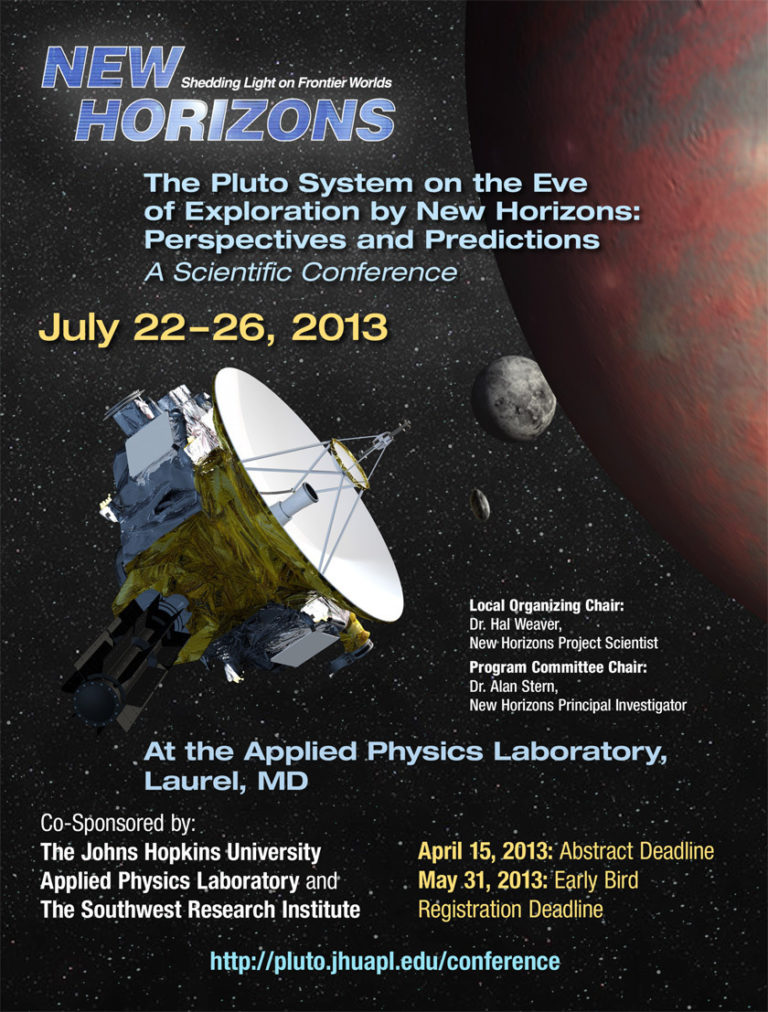Emily Lakdawalla • Jun 17, 2013
Great News: New Horizons to "stay the course" at Pluto
This is extremely good news: after more than a year of analysis, the New Horizons mission and NASA have concluded and agreed that New Horizons' originally-planned trajectory past Pluto is likely safe from dust. Dust has been a worry for New Horizons ever since a team led by Mark Showalter discovered Pluto's fourth moon two years ago. Further intense searches of the Pluto system yielded the announcement of a fifth moon and the intensification of the worry a year later.
The problem with all those little moons is that little impacts onto little moons produce lots of dust; the region near Pluto in the neighborhood of the moons is likely thick with it. Well, not thick, actually the amount of dust is very small in terms of mass, but just one particle of the right size in the wrong place at the wrong time could kill New Horizons before it finished taking data at Pluto. This would be bad for any space mission, but especially bad for New Horizons. Other flyby missions, like Voyager, returned a lot of their data in real-time; a mission-ending disaster would at least have seen data back to Earth from up to the moment of the end. New Horizons will be recording tons more data than the Voyagers, but returning very little of that haul to Earth before the close-approach phase of the mission. There's only so fast it can transmit data, even with a 2.7-meter-diameter dish, from all the way out at Pluto; and time pointed at Earth is time taken away from the precious moments close to Pluto when it would rather be doing science observations. So the nominal plan has New Horizons taking a year or so after passing Pluto to get all the precious data back. Which means it had better survive its passage through Pluto's potentially dusty system.

Anyway, there has been a lot of study of the problem and according to a statement issued by NASA today, "Unless significant new hazards are found, expect NASA’s New Horizons spacecraft to stay on its original course past Pluto and its moons, after mission managers concluded that the danger posed by dust and debris in the Pluto system is less than they once feared." They will continue to do work on two alternative trajectories, just in case a bad surprise awaits. Those alternatives are called SHBOTs, an acronym (pronounced "shabbat") that used to mean "Safe Haven Bail-Out Trajectory" but which the NASA statement writes out as "Safe Haven by Other Trajectory." Whatever.
The reason that this is such good news is because there has been a tremendous amount of work put into the science plans for the original trajectory. The New Horizons science team is a very small one, for financial reasons. Knowing they would have years to plan between Jupiter and Pluto, they put their very small team to very good use, using those years to methodically plan and refine every tiny moment of the encounter to maximize the science return from Pluto, Pluto's atmosphere, Charon, Nix, Hydra, and its newly found crop of tinier moons. If they suddenly had to switch now to a different trajectory, there is no way they would be able to produce a science plan as finely honed and scientifically rich as the one they have planned for the nominal trajectory. So this news means we will get the most out of our precious Pluto flyby.
Another reason this is a good thing (just pointed out to me by Alex Parker via Twitter) is that not having to divert to another trajectory saves fuel that will be valuable in targeting the future Kuiper belt object encounter, whatever and wherever that object (or, if we're very very lucky, objects) turns out to be.
There is going to be more information forthcoming about what to expect from the Pluto flyby next month, when the New Horizons mission will be holding a week-long conference on the state of Pluto science before New Horizons' arrival. I hope to attend some or all of the meeting and will be Tweeting and blogging away!
Support our core enterprises
Your support powers our mission to explore worlds, find life, and defend Earth. You make all the difference when you make a gift. Give today!
Donate

 Explore Worlds
Explore Worlds Find Life
Find Life Defend Earth
Defend Earth


